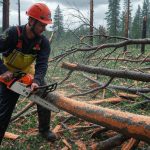Types of Tree Services
Trees, an essential part of both residential and commercial landscapes, require regular care to thrive and contribute to their surroundings. Tree services cover a variety of tasks designed to maintain tree health, aesthetics, and safety. Below, we explore some of the most common tree services and their importance.
Pruning and Trimming
Pruning and trimming are two vital tree care practices that involve the removal of unnecessary branches. Pruning is performed to eliminate dead, diseased, or damaged limbs, enhancing the tree’s health and structure. It’s also a preventive measure to reduce the risk of weak branches breaking during storms or high winds.
Trimming focuses on shaping trees for aesthetic purposes and controlling growth. It can improve the appearance of ornamental trees and shrubs, promote healthy development, and improve air circulation. Regular trimming also prevents trees from growing into power lines or interfering with structures.
Tree Removal
When a tree becomes unsafe due to disease, death, or structural instability, tree removal is necessary. This service is often used to prevent a dangerous tree from falling on a house, road, or utility line. Tree removal may also be required if a tree is causing property damage through invasive root systems.
Removing large trees is a complex and hazardous task that must be performed by skilled arborists using the right equipment. The process involves cutting down the tree in sections to ensure it’s removed safely, particularly in confined spaces or near buildings.
Stump Grinding and Removal
Once a tree is cut down, the remaining stump can be an eyesore or a tripping hazard. Stump grinding and removal services help eliminate these stumps, making the area safer and more aesthetically pleasing. Stump grinding involves using machinery to reduce the stump to wood chips, which can be repurposed for landscaping.
In some cases, the entire stump, along with its roots, may need to be removed to prevent underground damage or interference with future planting projects. Stump removal clears the space for new growth and prevents problems associated with decaying wood.
Planting and Transplanting
Tree planting and transplanting services involve introducing new trees to a landscape or relocating existing trees to a new site. Planting requires selecting the right tree species and planting it in the best location for sunlight, soil, and drainage conditions.
Transplanting involves moving mature trees to another spot. This complex process requires expert handling to avoid damaging the tree’s root system and minimize stress. Transplanting is often performed to preserve trees during construction or landscape redesigns.
Emergency Tree Services
Emergency tree services are critical following storms or accidents that cause trees to fall or branches to break. These services help quickly remove hazardous trees or debris from roads, buildings, or utility lines to prevent further damage.
Professional arborists are trained to handle emergency tree situations, ensuring that dangerous trees are removed safely and efficiently. They also provide services such as reinforcing storm-damaged trees to prevent future issues.
Tree Health and Disease Management
Tree health care involves diagnosing and treating diseases, pests, or nutrient deficiencies that threaten tree vitality. Arborists perform assessments to determine the best course of treatment, which may include pest control, soil treatments, or applying fungicides.
Preventative tree health care is essential for avoiding widespread disease outbreaks or severe infestations. Regular monitoring and treatment can keep trees strong and resilient to stress factors like drought, pests, and diseases.
Cabling and Bracing
When a tree has weak limbs or branches prone to breaking, cabling and bracing offer structural support. Cabling involves attaching steel cables to redistribute the weight of heavy limbs, while bracing involves installing rods to reinforce the tree’s structure.
These services are often used to preserve valuable or mature trees that are at risk of falling apart. By stabilizing weak limbs, cabling and bracing prevent structural failure and ensure the tree remains safe.
Lot Clearing
Lot clearing services are essential for preparing a property for new construction or landscaping projects. This service involves the removal of trees, brush, and other vegetation to clear the land for development.
Professional lot clearing ensures that the process is done efficiently and safely, minimizing environmental impact and preserving trees that can be integrated into the new design. Arborists also handle the disposal of debris, ensuring compliance with local environmental regulations.
Storm Cleanup
After a severe weather event, trees and landscapes are often left damaged by strong winds, heavy rain, or snow. Storm cleanup services help restore order to the landscape by removing fallen trees, broken limbs, and other debris.
Storm cleanup ensures that roads, driveways, and walkways are clear and safe, and it helps prevent further damage to structures from fallen trees. Damaged trees may also be pruned or stabilized to promote recovery and prevent future risks.
Fertilization and Soil Management
Healthy trees rely on rich soil and essential nutrients to grow strong. Fertilization services ensure that trees receive the right balance of nutrients, especially in urban areas where natural soil fertility may be lacking. Arborists test the soil and apply fertilizers that provide vital nutrients.
Soil management also includes improving soil structure through techniques like aeration, which reduces compaction and increases water and nutrient absorption. Healthy soil promotes better root development and overall tree health.
Arborist Consultation and Risk Assessment
Arborist consultation services provide expert advice on tree health, care, and maintenance. Arborists evaluate the condition of trees and recommend treatments to address issues like disease, pest infestations, or structural problems.
A risk assessment involves examining trees for potential hazards, such as limbs at risk of falling, decay, or unstable root systems. Arborists offer solutions to mitigate these risks, including pruning, cabling, or removal.
Root Care and Management
Roots are vital to a tree’s health, but they can sometimes cause problems when they grow too close to buildings, roads, or underground utilities. Root care services help manage and control the growth of tree roots to prevent damage to structures.
Root management may involve root pruning, redirecting growth, or using aeration techniques to improve soil conditions. Healthy roots contribute to the tree’s stability and longevity, preventing issues like root rot or structural instability.
Pest Control
Insect infestations can significantly harm trees, leading to disease, decay, and even death. Pest control services target specific pests, such as beetles, aphids, or caterpillars, using environmentally friendly treatments.
Regular pest monitoring and early intervention help protect trees from extensive damage. Arborists use treatments like insecticidal sprays, injections, or natural predators to manage pest populations and maintain healthy trees.
Tree Preservation
Tree preservation services are focused on protecting valuable trees during construction or renovation projects. Arborists assess the impact of planned work on trees and implement strategies to minimize damage, such as fencing, root pruning, and mulching.
Preserving mature or heritage trees adds ecological and aesthetic value to the landscape, ensuring they continue to thrive even after construction work is complete.
Hazard Assessment
Hazard assessments are essential for identifying trees that pose safety risks due to structural weaknesses or decay. Arborists evaluate trees for signs of instability, such as cracks, disease, or root damage, and recommend appropriate actions to mitigate the risks.
Based on the findings, the tree may need pruning, bracing, or removal to ensure public safety. Regular assessments help property owners prevent accidents and protect their investments in the landscape.


